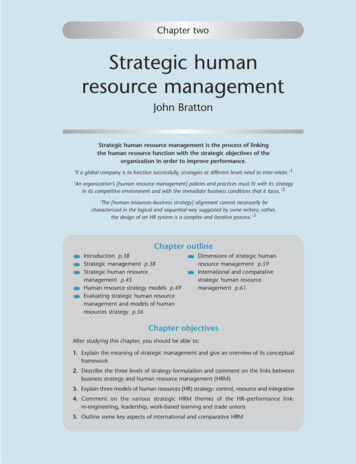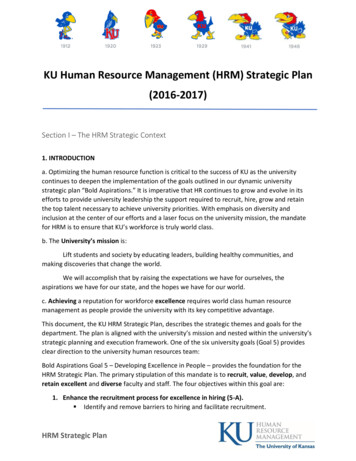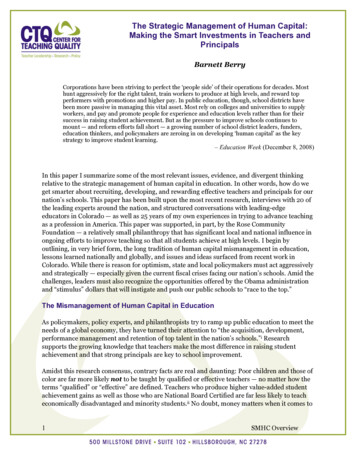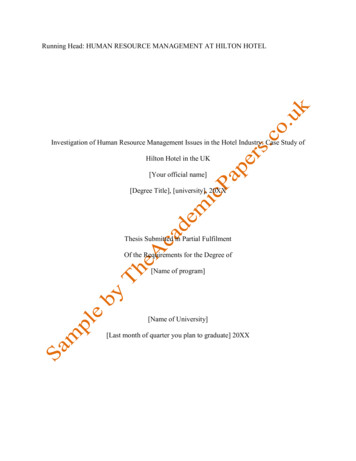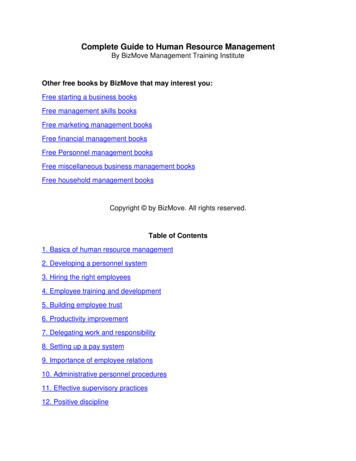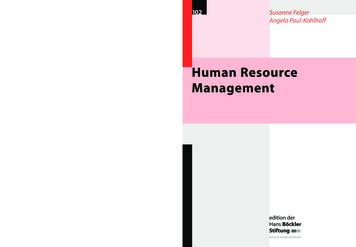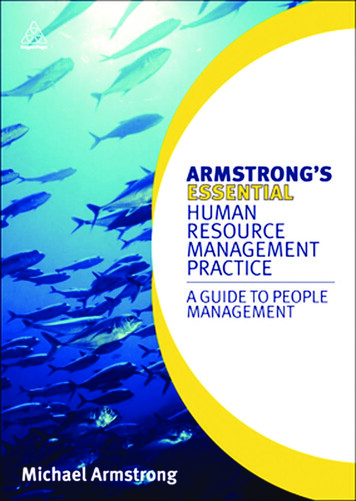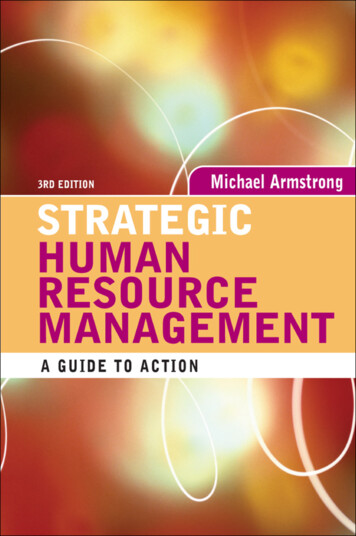
Transcription
iSTRATEGICHUMAN RESOURCEMANAGEMENT
iiiSTRATEGICHUMAN RESOURCEMANAGEMENTA GUIDE TO ACTION3RD EDITIONMichael ArmstrongLondon and Philadelphia
ivPublisher’s noteEvery possible effort has been made to ensure that the information contained in this book isaccurate at the time of going to press, and the publishers and authors cannot accept responsibility for any errors or omissions, however caused. No responsibility for loss or damage occasioned to any person acting, or refraining from action, as a result of the material in thispublication can be accepted by the editor, the publisher or the author.First published in Great Britain in 1992 as Human Resource Management: Strategy and ActionSecond edition published as Strategic Human Resource Management: A Guide to Action 2000Third edition 2006Apart from any fair dealing for the purposes of research or private study, or criticism orreview, as permitted under the Copyright, Designs and Patents Act 1988, this publication mayonly be reproduced, stored or transmitted, in any form or by any means, with the priorpermission in writing of the publishers, or in the case of reprographic reproduction in accordance with the terms and licences issued by the CLA. Enquiries concerning reproductionoutside these terms should be sent to the publishers at the undermentioned addresses:120 Pentonville RoadLondon N1 9JNUnited Kingdom525 South 4th Street, #241Philadelphia PA 19147USAwww.kogan-page.co.uk Michael Armstrong, 1992, 2000, 2006The right of Michael Armstrong to be identified as the author of this work has been assertedby him in accordance with the Copyright, Designs and Patents Act 1988.ISBN 0 7494 4511 4British Library Cataloguing-in-Publication DataA CIP record for this book is available from the British Library.Library of Congress Cataloging-in-Publication DataArmstrong, Michael, 1928–Strategic human resource management : a guide to action / MichaelArmstrong.-- 3rd ed.p. cm.Includes bibliographical references and index.ISBN 0-7494-4511-41. Personnel management. I. Title.HF5549.A89784 2005658.3 01--dc222005024402Typeset by Saxon Graphics Ltd, DerbyPrinted and bound in the United States by Thomson-Shore, Inc.
vContentsPrefaceixPART 1 THE FRAMEWORK OF STRATEGIC HUMAN RESOURCEMANAGEMENT1Human resource managementHuman resource management defined 3; Models of HRM 4;Aims of HRM 6; Characteristics of HRM 8; Reservations aboutHRM 13; HRM and personnel management 1632Strategy: concept and processStrategy defined 19; The concept of strategy 20; Thefundamentals of strategy 22; The formulation of strategy 24193Strategic human resource management: concept and processStrategic HRM defined 29; The meaning of strategic HRM 30;Aims of strategic HRM 30; Approaches to strategic HRM 31;Limitations to the concept of strategic HRM 35; Conclusion 35294HR strategiesHR strategies defined 37; Types of HR strategies 38; Criteria foran effective HR strategy 4237
vi l ContentsPART 2 STRATEGIC HUMAN RESOURCE MANAGEMENT INACTION5 Formulating and implementing HR strategiesFundamental process considerations 48; Characteristics of theprocess 49; Developing HR strategies 52; Setting out thestrategy 64; Conducting a strategic review 65; Implementing HRstrategies 69476 Improving business performance through strategic HRMHow HR impacts on organizational performance 72; How HRMstrategies make an impact 75; How strategic HRM conceptsimpact on practice 77717 Roles in strategic HRMThe strategic role of top management 79; The strategic role offront-line management 79; The strategic role of the HR director 81;The strategic role of HR specialists 8179PART 3 HR STRATEGIES8 Strategies for improving organizational effectivenessStrategies for improving organizational effectiveness 90;Strategies for organizational development 91; Strategies fororganizational transformation 95; Strategies for culturemanagement 99; Strategies for knowledge management 106;Commitment strategy 110; Strategies for developing a climateof trust 112; Quality management strategies 114; Continuousimprovement strategies 115; Customer service strategy 115899 Resourcing strategyResourcing strategy defined 117; The objective of resourcingstrategy 117; The strategic HRM approach to resourcing 118;Integrating business and resourcing strategies 118; Bundlingresourcing strategies and activities 119; The components ofemployee resourcing strategy 120; Human resourceplanning 120; Resourcing plans 123; Retention strategy 126;Flexibility strategy 130; Talent management strategy 13011710 Learning and development strategyStrategic HRD 133; Strategies for creating a learningculture 136; Organizational learning strategies 137;133
Contents l viiLearning organization strategy 138; Individual learningstrategies 13911 Strategies for managing performancePerformance management 142; Performance managementdefined 142; Purpose of performance management 143;Performance management concerns 143; The scope ofperformance management strategy 144; The process ofperformance management 145; Conclusion 14714112 Reward strategyReward strategy defined 149; Why have a reward strategy? 149;Characteristics of reward strategy 150; The structure of rewardstrategy 150; The content of reward strategy 151; Guidingprinciples 154; Developing reward strategy 155; Effectivereward strategies 157; Reward strategy and line managementcapability 15814913 Employee relations strategyEmployee relations strategy defined 159; Concerns of employeerelations strategy 160; Strategic directions 160; The backgroundto employee relations strategies 161; The HRM approach toemployee relations 161; Policy options 163; Formulatingemployee relations strategies 163; Partnership agreements 164;Employee voice strategies 166159ReferencesFurther readingAuthor indexSubject index169179185189
ixPrefaceThis third edition of Strategic Human Resource Management has been substantially revised to incorporate the latest research and thinking. A number ofchapters such as those concerned with strategic HRM in general in Parts 1and 2 have been almost completely rewritten, as has Chapter 12 on rewardstrategies. A new chapter on enhancing organizational effectiveness hasbeen included and revisions made to all the other chapters.The book is set out under the following headings: Part 1: The framework of strategic human resource management. Thisprovides an introduction to HRM, the general concept of strategy andthe process of strategic HRM. Part 2: Strategic human resource management in action. This describes theformulation and implementation of HRM strategies, the impact ofstrategic human resource management, the strategic contribution of theHR function, and roles in strategic HRM. Part 3: HR strategies. This covers each of the main areas in which HRstrategies are developed, namely: enhancing organizational effectiveness,resourcing, learning and development, managing performance, rewardand employee relations.
1Part 1The framework of strategichuman resourcemanagement
31Human resourcemanagementIn this chapter, the concept of human resource management (HRM) isdefined initially and the various models of HRM are described.Consideration is then given to its aims and characteristics. The chapterconcludes with a review of reservations about HRM and the relationshipbetween HRM and personnel management.HUMAN RESOURCE MANAGEMENT DEFINEDHuman resource management is defined as a strategic and coherentapproach to the management of an organization’s most valued assets – thepeople working there who individually and collectively contribute to theachievement of its objectives.John Storey (1989) believes that HRM can be regarded as a ‘set of interrelated policies with an ideological and philosophical underpinning’. Hesuggests four aspects that constitute the meaningful version of HRM:l a particular constellation of beliefs and assumptions;l a strategic thrust informing decisions about people management;
4 l The framework of strategic HRMl the central involvement of line managers;l reliance upon a set of ‘levers’ to shape the employment relationship.MODELS OF HRMThe matching model of HRMOne of the first explicit statements of the HRM concept was made by theMichigan School (Fombrun et al, 1984). They held that HR systems and theorganization structure should be managed in a way that is congruent withorganizational strategy (hence the name ‘matching model’). They furtherexplained that there is a human resource cycle (an adaptation of which isillustrated in Figure 1.1), which consists of four generic processes or functions that are performed in all organizations. These are:l selection – matching available human resources to jobs;l appraisal (performance management);l rewards – ‘the reward system is one of the most under-utilized andmishandled managerial tools for driving organizational performance’; itmust reward short- as well as long-term achievements, bearing in mind that‘business must perform in the present to succeed in the future’;l development – developing high-quality formanceDevelopmentFigure 1.1 The human resource cycle (adapted from Fombrun et al, 1984)
Human resource management l 5The Harvard frameworkThe other founding fathers of HRM were the Harvard school of Beer et al(1984) who developed what Boxall (1992) calls the ‘Harvard framework’.This framework is based on the belief that the problems of historicalpersonnel management can only be solved:when general managers develop a viewpoint of how they wish to seeemployees involved in and developed by the enterprise, and of what HRMpolicies and practices may achieve those goals. Without either a centralphilosophy or a strategic vision – which can be provided only by generalmanagers – HRM is likely to remain a set of independent activities, eachguided by its own practice tradition.Beer and his colleagues believed that ‘today, many pressures are demandinga broader, more comprehensive and more strategic perspective with regardto the organization’s human resources’. These pressures have created a needfor: ‘A longer-term perspective in managing people and consideration ofpeople as potential assets rather than merely a variable cost’. They were thefirst to underline the HRM tenet that it belongs to line managers. They alsostated that: ‘human resource management involves all management decisions and action that affect the nature of the relationship between the organization and its employees – its human resources’.The Harvard school suggested that HRM had two characteristicfeatures: 1) line managers accept more responsibility for ensuring thealignment of competitive strategy and personnel policies; 2) personnel hasthe mission of setting policies that govern how personnel activities aredeveloped and implemented in ways that make them more mutually reinforcing. The Harvard framework as modelled by Beer et al is shown inFigure 1.2.According to Boxall (1992) the advantages of this model are that it:l incorporates recognition of a range of stakeholder interests;l recognizes the importance of ‘trade-offs’, either explicitly or implicitly,between the interests of owners and those of employees as well asbetween various interest groups;l widens the context of HRM to include ‘employee influence’, the organization of work and the associated question of supervisory style;l acknowledges a broad range of contextual influences on management’schoice of strategy, suggesting a meshing of both product market and sociocultural logics;l emphasizes strategic choice – it is not driven by situational or environmental determinism.
6 l The framework of strategic HRMStakeholderinterests: shareholders management employees government unionsSituational factors: work forcecharacteristics business strategyand conditions managementphilosophy labour market unions task technology laws and socialvaluesHRM policychoices: employeeinfluence humanresource flow rewardsystems work systemsHR outcomes: commitment congruence costeffectivenessLong-termconsequences: individualwell-being organizationaleffectiveness societalwell-beingFigure 1.2 The Harvard model of HRM (from Beer et al, 1984)The Harvard model has exerted considerable influence over the theory andpractice of HRM, particularly in its emphasis on the fact that HRM is theconcern of management in general rather than the personnel function inparticular.AIMS OF HRMThe overall purpose of human resource management is to ensure that theorganization is able to achieve success through people. As Ulrich and Lake(1990) remark: ‘HRM systems can be the source of organizational capabilities that allow firms to learn and capitalize on new opportunities.’Specifically, HRM is concerned with achieving objectives in the areassummarized below.Organizational effectiveness‘Distinctive human resource practices shape the core competencies thatdetermine how firms compete’ (Cappelli and Crocker-Hefter, 1996).
Human resource management l 7Extensive research (see Chapter 4) has shown that such practices can make asignificant impact on firm performance. HRM strategies aim to supportprogrammes for improving organizational effectiveness by developingpolicies in such areas as knowledge management, talent management andgenerally creating ‘a great place to work’. This is the ‘big idea’ as describedby Purcell et al (2003), which consists of a ‘clear vision and a set of integratedvalues’. More specifically, HR strategies can be concerned with the development of continuous improvement and customer relations policies.Human capitalThe human capital of an organization consists of the people who workthere and on whom the success of the business depends. Human capitalhas been defined by Bontis et al (1999) as follows: ‘Human capital represents the human factor in the organization; the combined intelligence,skills and expertise that gives the organization its distinctive character.The human elements of the organization are those th
Human resource management is defined as a strategic and coherent approach to the management of an organization s most valued assets the people working there who individually and collectively contribute to the achievement of its objectives. John Storey (1989) believes that HRM can be regarded as a set of inter- related policies with an ideological and philosophical underpinning . He suggests .
